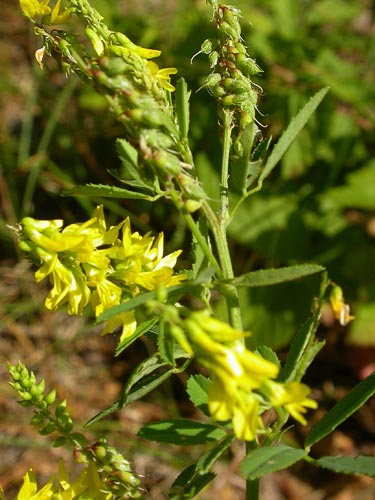Relatives
Melilotus neapolitanus Ten. - Neapolitan melilot.
Taxonomic position.
Family Fabaceae Lindl., genus Melilotus Mill.Main synonyms:
M. gracilis DC., M. parviflorus Stev. ex Trautv.Morphology and biology.
Annual plant. Stems straight, branched, 15-40 cm tall, pubescent with pubescence stronger in the upper part of plant. Stipules lanceolate, acuminate, entire, 3-4 mm long. Leaflets oblong-cuneate, somewhat obtuse at the apex. Leaflets of upper leaves indistinctly dentate at margins, sometimes pubescent beneath with long hairs. Inflorescence a dense raceme of 5-15 flowers, 1-2 cm long, elongated when in fruit. Pedicels about 1 mm long. Flowers 4-5 mm long, light yellow, horizontally deflected. Calyx 2 mm long, thin, pubescent up to the half. Calyx teeth acuminate. Standard as long as keel, wings slightly shorter. Ovary broadly lanceolate, sessile, pubescent with short adpressed hairs, with two ovules. Pods glabrous, 3 mm long and wide, subspherical, at the end attenuate into a beak. Pod valves pitted-wrinkled when mature. Seeds smooth, about 2 mm long, brown, finely tuberculate, 1 or 2 in each pod. Flowers in May, fruits in June. Entomophilous. Zoochore. 2n=16.Distribution.
General distribution: West and East Mediterranean, Asia Minor, Iran. Former USSR: European part - Crimea; Caucasus - East and South Transcaucasia.Ecology.
Mountain slopes, among shrubberies, at roadsides.Use and economic value.
Wild relative of cultivated melilot species. Forage.References:
Fedorov AA., Tzvelev NN., ed. 1987. Flora of the European part of the USSR. V.6. Leningrad: Nauka. P.179, 182. (In Russian).Bobrov EG. 1945. Melilot - Melilotus Adans. In: Shishkin BK., ed. Flora URSS. V.11. P.188-189. (In Russian).
Cherepanov SK. 1995. Vascular plants of Russia and adjacent states (the former USSR). St.Petersburg. 990 p. (In Russian).


